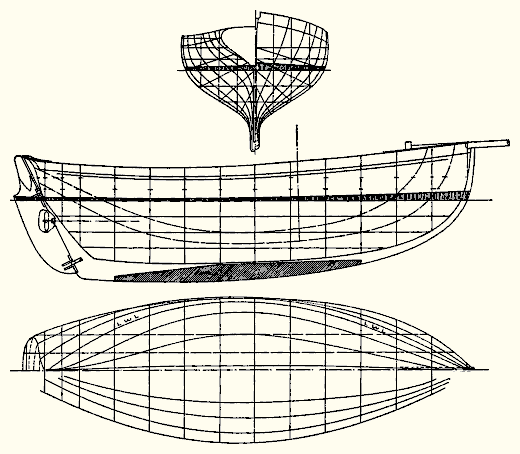
| Wild Duck A 32' 7" Jib-Headed Cutter By William Atkin |
| A 32-Foot Cruiser | |
| The 28-foot cutter Fore An' Aft described in Three Little Cruising Yachts (reprinted in Of Yachts and Men) is a near relation to this latest of the family. However, both the rig and the proportions of Wild Duck differ widely from the former. Their deck arrangements are very different; and this also holds true of the interior layouts as well. Wild Duck is a very big boat for her overall length. Principally this is so because her long waterline makes it possible to use nearly all of the length for accommodations. Little is wasted in overhang either forward or aft. Short-ended boats are excellent in rough water, provided there is sufficient flare to the topsides both forward and aft; and provided the ends of the boat balance. Having designed over a dozen very short-ended auxiliaries, and sailed in six of these I can assure prospective builders that craft like Wild Duck have so many excellent points that the very few less desirable ones can be forgotten and forgiven. | |

| |
| The sail plan shows a compact jib-head rig, the total sail area being 662 square feet. The jib stay and staysail stay lead through sheaves at their lower ends, thence to turnbuckles fitted to the top of the bow sprit. This not only takes much of the strain from the turnbuckle but permits the snap hooks, or shanks, to render all the way to the deck. The shrouds are taken up at the chain plates with lanyards and deadeyes. I have shown flexible wire in place of the usual tarred hemp for lanyards. The chain plates lead out over channels; this arrangement gives additional spread to the shrouds; but the advantage gained is in the direct pull on the chain plates without any side pressure or side thrust against the bulwark rail. | |

| |
| The interior is laid out for the accommodation of four. The galley is aft, having coal range, sink, dish lockers, coal locker, etc., on the port side; and ice box opposite. The top of the ice box will be used as a chart table. There is a big hanging locker with shelves between the main cabin and the galley, and the toilet is opposite. Opening the locker doors and the toilet room doors forms a compartment the full width of the cabin. The doors are swung at opposite corners and that the toilet room can be shut off from either the galley or the main cabin; or both. The main cabin is arranged to sleep two; one berth being raised above the sofa on the starboard side and kept made up during the day; the other being both a sofa and berth. There are large lockers over the sofa-berth. Water tanks are under the sofas. The cabin table is attached to the butt of the mast, and has a single leg at its after end. The forward cabin has two built in berths, small bureau and convenient hanging space. The headroom under the cabin trunk is 5 feet 11 inches; this measured under the carlins. | |

| |
Wild Duck is 32 feet 7 inches over all; 30 feet 9 inches on the waterline; 10 feet 6 inches in breadth; and 6 feet draft. It will be seen from this that the overhang forward is only 6 inches; aft only 16 inches. The body plan shows wholesome sections with ample flare. The keel is long and has little drag. There is generous freeboard without too much sheer. A short-ended hull having a bold sheer line appears too much like a chopping bowl. If you must have a lot of sweep in the sheer line have it in combination with a model carrying much longer overhangs than Wild Duck's. High ends are not always desirable, naturally cause excess windage, and with moderate heights forward and aft combined with a bold sheer line the freeboard amidships is likely to be insufficient. The lead keel weighs 8,650 pounds, and there must be another 2,000 pounds of inside ballast. Boats of short overhang model require rather more ballast in proportion to their displacement than boats having overhangs. This is because the long overhang model carries a good piece of her constructional weight in her deck and ends above the water line; while the short-ended models have comparatively little weight in decks and overhangs. The motor, a Red Wing 8-10 h.p. two cylinder slow-speed type, is installed under the cockpit and bridge deck. The shaft line is absolutely parallel to the water line; however the flywheel end of the motor is splayed to the port side. Having the propeller in the center line of the boat this side splay corrects the action of the torque of the propeller. It is this torque that always causes the bow to work off in an opposite direction to that in which the propeller revolves. Gasoline tanks are fitted on the cockpit floor. These are covered by the side seats. | |
| Plans for Wild Duck are $200 MYSTIC SEAPORT MUSEUM SHIPS PLANS STORE https://store.mysticseaport.org/ships-plans/ shipsplanstore@mysticseaport.org
+1 (860) 572 5360 | |
| BACK TO PLAN LIST | |